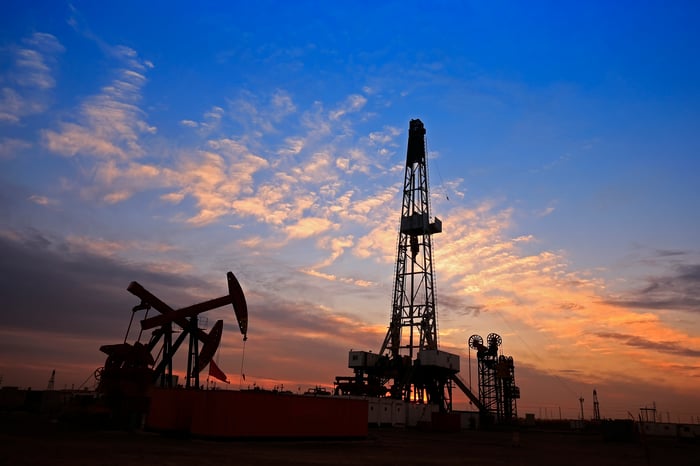Chesapeake Energy (CHKA.Q) believes it has a plan to get through what continues to be a very challenging period. The energy company unveiled that strategy along with its fourth-quarter results, which came in a bit better than expected.
Here's a look at those numbers, as well as what the financially strapped oil and gas producer plans to do to manage through its currently tough situation.
Drilling down into Chesapeake Energy's fourth-quarter earnings
Chesapeake Energy produced an average of 126,000 barrels of oil per day (BPD) during the fourth quarter, which was up nearly 45% year over year. That surge in crude-oil output pushed it to 26% of its total production mix, the highest in its history. Total production, meanwhile, rose about 3% during the quarter as surging oil output more than offset declining natural gas and natural gas liquids (NGL) production.

Image source: Getty Images.
That increase in higher-margin oil output helped push the company's underlying earnings per barrel of oil equivalent up 15% year over year -- even though oil and gas prices were higher in the year-ago period. Because of that, the company kept its adjusted loss to $0.04 per share, which beat the analysts' consensus estimate by $0.02 per share.
Fueling Chesapeake's fast-paced oil growth was the addition of its Brazos Valley assets in Texas' Eagle Ford Shale, which it acquired earlier this year. That business produced 40,000 BPD.
Chesapeake also benefited from its position in Wyoming's Powder River Basin. Oil output in that region spiked 36% year over year to 19,000 BPD. Those dual fuels helped more than offset the impact of production declines elsewhere, as well as asset sales.
What's ahead for Chesapeake Energy in 2020
Chesapeake Energy outlined a two-part strategy to help it manage through 2020's challenges:
- A 30% reduction in capital spending to a range of $1.3 billion-$1.6 billion, with 80% of that money allocated to its highest-margin oil opportunities. This spending level will enable the company to maintain a relatively flat oil production profile, though total output will decline due to falling gas volumes.
- A plan to sell between $300 million and $500 million of non-core assets.
Chesapeake's 2020 game plan will accomplish two important goals. First, by reducing spending by 30%, it should produce enough cash at current commodity prices to finance its capital budget, with room to spare. Second, the asset sales will enable the company to repay the $302 million in debt that's maturing this year. Meanwhile, the free cash it generates after covering capital expenses, along with the excess cash proceeds it could produce from asset sales, will give it a head start on 2021's $293 million in remaining debt maturities.
The company, however, needs a lot to go its way for its 2020 plan to be a success. Not only do oil and gas prices need to stabilize, but the company also needs to find buyers for the assets it intends to sell, which could be tough to do in the current environment. It was reportedly working on a deal last year to sell its Hayneville shale assets for as much as $1 billion. However, that sale seems to have stalled out due to persistently low natural gas prices and Chesapeake Energy's ability to refinance some debt last year.
Given the current market turbulence, if oil and gas prices keep slumping and the company can't find buyers for its assets, it might have no choice but to reorganize through bankruptcy.
2020 could be a make-or-break year for Chesapeake Energy
Chesapeake Energy is working hard to navigate through what remains a challenging oil market so that it can stay at least one step ahead of addressing its balance-sheet issues. While the energy company believes it can do that this year, it needs oil and gas prices to cooperate, as well as find buyers willing to pay a fair price for its assets.
If everything goes according to plan, then Chesapeake will live to fight another day. However, it remains a risky bet for investors because there's a possibility that the stock might end up worthless if the company needs to reorganize in bankruptcy.





